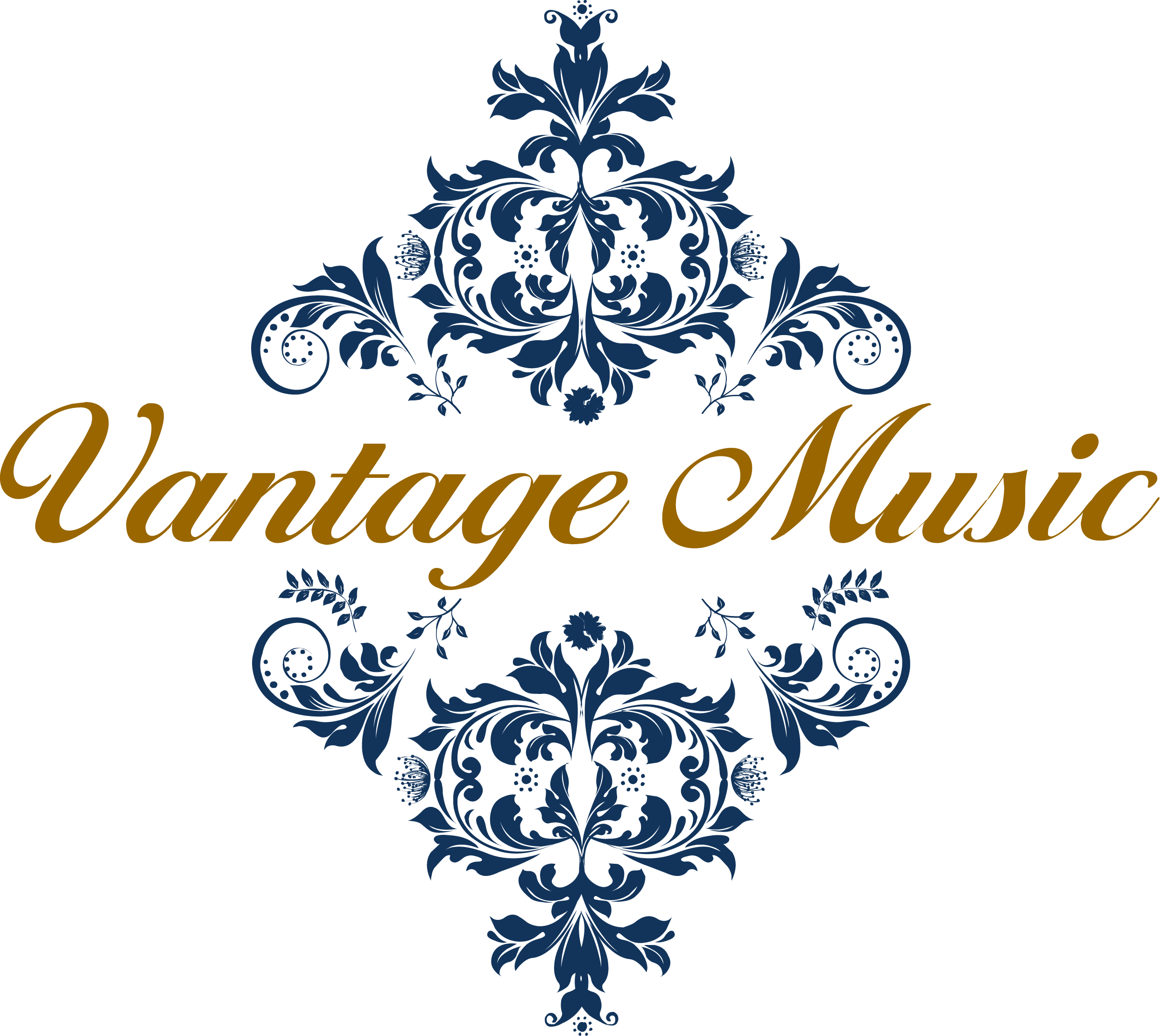By Tamami Honma | April 2018
In the previous article in this two part series, we explored how music and art have been jointly influenced by Nationalism. Stylistic trends are clearly shaped by the cultural forces that work within geographical and political boundaries. However, there have been even more influential and groundbreaking transformations in the aesthetics of art and music that have cut across such boundaries: artistic and musical revolutions arising from the evolutionary changes brought about by social progress and new intellectual developments.
THE RENAISSANCE (c 1300-1700): A New Dawn of Western Art and Music
Italy was the home of the Renaissance, a cultural movement that began in the 14th century leading to a remarkable period of intellectual development in literature, philosophy, art, music, politics, science, and religion. The influence of the Renaissance, which literally means “rebirth” in French, spread across Europe aided in part by the invention of the printing press in 1440 by Johannes Gutenberg in Germany, leading to a burst of intense learning and dissemination of ideas unlike anything that had ever happened previously in human history.
The origins of the Renaissance can be traced back to a number of factors. Increasing political stability and rising prosperity in parts of Europe particularly in Central and Northern Italy gave rise to new social conditions that facilitated capitalism and made it easier to break away from the feudalism of the past. Writers such as Dante (1265–1321), Petrarch (1304-1374) and Giovanni Boccaccio (1313-1375) sought to reignite the intellectual traditions of the Roman Empire and Ancient Greece which valued scholarly learning. Another more surprising factor may have been the Black Death that led to one of the most devastating pandemics the world had seen. Reaching a peak between 1346 and 1353, it’s estimated between 75 to 200 million people across Europe and Asia were killed by the disease, representing a third or more of the population. As it was common practice among rulers of nations to keep the masses uneducated in order to make them more easily manipulated, millions of people died from unhygienic practices brought about in part from their inability to learn from one another.

Tiziano Vecellio, Bacchus and Ariadne (c. 1520-1523) – National Gallery, Public Domain, https://commons.wikimedia.org/w/index.php?curid=611549.

Giotto di Bondone, Kiss of Judas (c. 1304-1306) – Web Gallery of Art: Image, Wikimedia Commons, Public Domain, https://commons.wikimedia.org/w/index.php?curid=29521850.
So it is one of the great ironies that terrible though it was, the Black Death may have helped create conditions for the Renaissance to flourish. Among the biggest casualties of the disease, were the monks who often visited the sick. As they were also responsible for copying religious texts, with their numbers much reduced, there was strong demand for more efficient printing methods. The advent of the printing press came at just the right time to fill in the gap and to facilitate the spread of information. Also with so many deaths, the public’s confidence in the Church fell especially as the new priests who came in as replacements were not as well-trained as their predecessors. The Church’s reputation suffered and secularism spread. The philosophy of humanism, a belief in rational and critical thinking while rejecting the supernatural, took hold, accompanied by new interest in painting and music that sparked the development of oil-based paint, and new compositions including secular dance and other non-religious subject matter.
The lower class also became wealthier as they inherited property from the dead. More could afford to purchase books and they could sell old clothing for rags, which could then be used to make paper. Before the invention of the printing press, only parchment and vellum were used to make books. These required an enormous amount of resources and time. 170 calf skins and 300 sheepskins cleaned and made thin enough were needed to make just one copy of the Bible.

Michelangelo Buonarroti, Doni Tondo (‘Holy Family’) (1506) – Google Cultural Institute, Public Domain, https://commons.wikimedia.org/w/index.php?curid=13514988.
The center of the Renaissance was in Florence, which was home to the creation of many celebrated artworks, thanks in large part to the strong support of the Medici family. The family accumulated wealth and power during the 13th century but the peak of their dynastic influence began in 1434 with the rise to power of Cosimo de’ Medici and continued for three centuries until 1737 when the family finally lost its grip after failing to produce an heir. During this period, the family produced no less than four popes, and consistently supported the arts, science, literature and music. They were the patrons of such outstanding artists as Donatello, Raphael, Michelangelo and Leonardo da Vinci.
The most notable supporters of musicians were Lorenzo the Magnificent, his son Giovanni, and Ferdinando de’ Medici. They contributed significantly to how music was presented by creating musical festivals for private or official occasions, and by retaining musicians and dancers at court. Also Catherine de’ Medici (1519-1589), through marriage, became Queen of France and for three decades held famously lavish court festivals known as magnificences that would each last for days and feature dramas, music, scenery, and dance including early forms of ballet. These festivals were not only widely influential in the French Renaissance movement – today there are dance and opera companies that can trace their beginnings back to her – but news of them also reverberated back to Italy. In 1597 Florence saw the world’s first opera, Dafne, which was an attempt to recreate Greek tragedy but now set to music by Jacopo Peri with the help of poet Ottavio Rinuccini. Although the libretto survives the music was lost but a surviving opera Euridice (1600) is still performed today. Following this, Claudio Monteverdi (1567-1643) also in Italy pioneered the further advancement of opera. Although many of his scores have also been lost, his opera L’Orfeo (1607) is still widely performed. He simultaneously did much to bring the secular influences into ‘old’ church music.
Ferdinando de’ Medici, Grand Prince of Tuscany (1663-1713) is remembered today primarily as a patron of music. An excellent musician himself, he attracted the best musicians to Florence and thus made it into an important musical center. He recruited the talents of Bartolomeo Cristofori who is attributed to have subsequently invented the piano through his innovations in keyboard action. Among other musicians that Ferdinando invited to Florence were Alessandro Scarlatti, Domenico Scarlatti and G.F. Handel. Handel’s opera Rodrigo was first performed in Florence in 1708. Ferdinando kept up correspondence with Alessandro Scarlatti and hosted five of his operas in his private theater. In 1711, he received the dedication of Antonio Vivaldi’s L’estro Armonico while Arcangelo Corelli in 1714 dedicated his 12 Concerti Grossi to Ferdinando’s sister Anna Maria Luisa de’ Medici.
There were many other celebrated Renaissance composers but mention should also be made of Giovanni Palestrina (1525-1594) in Rome, Orlando de Lassus (1532-1594) in the Netherlands, and Thomas Tallis (1510-1585) were among some of the most famous and influential composers in Europe during the 16th century. There was much change occurring in England after the Protestant Reformation to help establish a stronger identity for the Anglican Church. Queen Elizabeth I granted Tallis and his pupil, William Byrd the exclusive rights to use England’s printing press to publish music. Byrd had won her favor by writing many works for her favorite instrument and also by setting into song Queen Elizabeth’s poem that thanked God for defeating the Catholic Spaniards.
Another remarkable feat of human ingenuity that arose during the Renaissance could be seen in the building of great cathedrals. They were constructed on ever more grandiose scales to evoke feelings of exaltation to any who walked in. Everything was done to exemplify the power of the higher realms including elaborate ornamentation with stained glass effects that were like none that any had seen before and acoustics that would make sounds appear to emanate from the heavens filling the listener with a feeling of glorification. Where music is performed has always been a major consideration even more so in days without any means of artificial amplification.
Over time, numerous instrumental combinations and sound effects were exploited in these cathedrals. Wind instruments and vocal ensembles were sometimes separated into multiple groups strategically positioned in different parts of the building creating new opportunities for blending and countering sonorities. Thus architecture began to play an interesting role in the compositional process sometimes resulting in astonishing results. A wonderful example is Spem in alium by Tallis, a motet, which calls for no less that forty distinct voices divided into eight choirs. The magnificent cathedral of San Marcos Basilica in Venice with its multiple lofts gave rise to what is known as Venetian polychoral style, that too involved separate choirs singing in alternation with works by Adrian Willaert, Giovanni Gabrieli and Claudio Monteverdi. The importance of music to San Marcos, was underlined in Gentile Bellini‘s painting, Procession della croce in piazza di San Marco, that features a large religious procession in San Marcos square but one that includes groups of wind instrumentalists with cornets and trombones, and a vocal group with viol and lute.
All in all, the Renaissance represented a crucial bridge between the Medieval era and the modern age, a period when new ideas transformed art, music, science, philosophy, and human thinking in general, often in ways that involved the interaction between these different disciplines. One wonders why more people of money and influence do not look back in history on this hugely fertile period of human creativity and recognize more fully the need for sponsorship and patronage today in order to enhance the culture in which we live.

Inside St. Mark’s Basilica – By Par Keete 37 – Travail personnel, CC BY 4.0, https://commons.wikimedia.org/w/index.php?curid=42786383
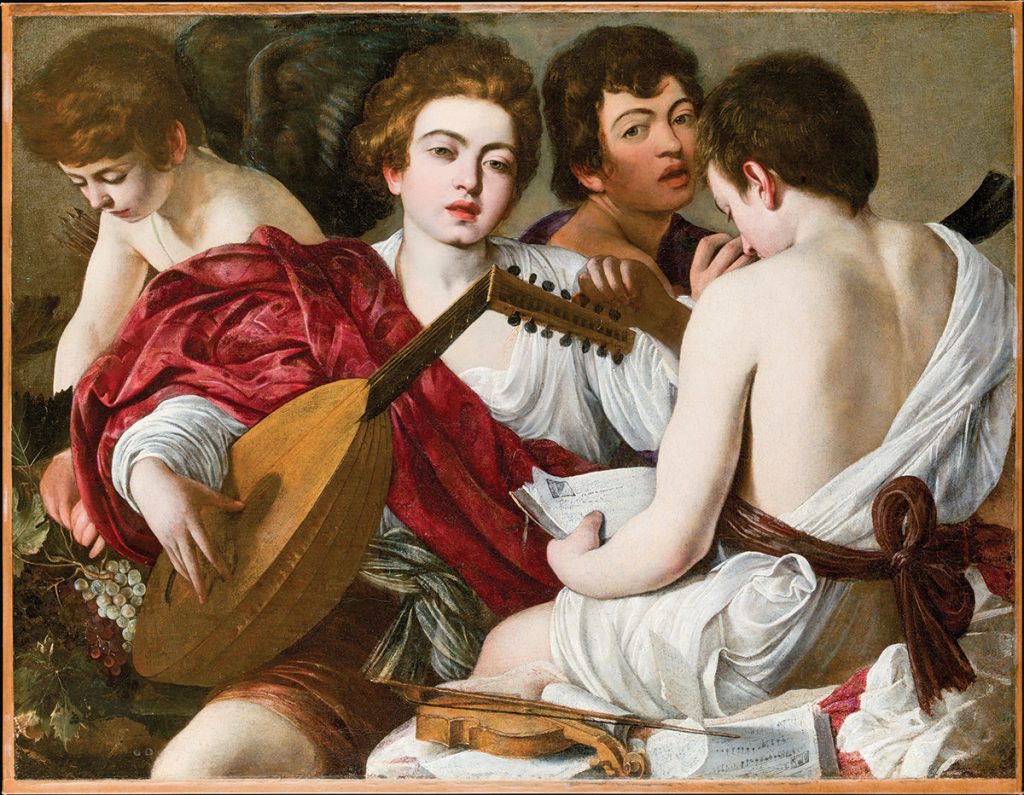
Michelangelo Merisi da Caravaggio, The Musicians (c. 1595), by Metropolitan Museum of Art, Public Domain, https://commons.wikimedia.org/w/index.php?curid=10257904
BAROQUE AND THE AGE OF REASON (c. 1600-1750)
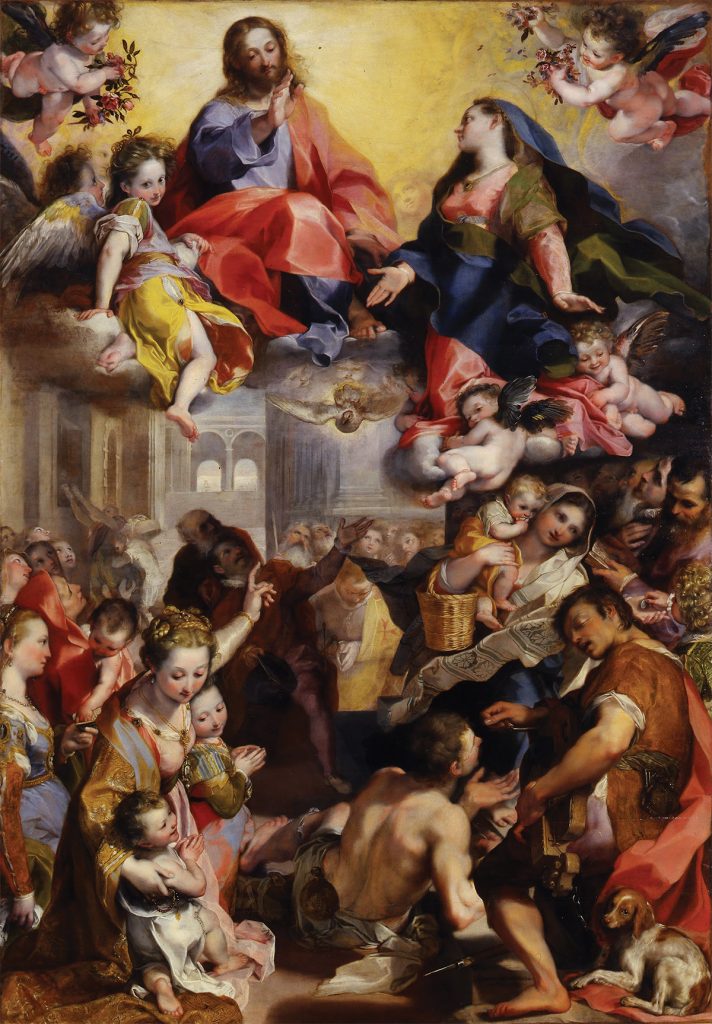
ederico Barocci, Madonna del Popolo (1579) – By AgFEhERCzsNS0A at Google Cultural Institute, zoom level maximum, Public Domain, https://commons.wikimedia.org/w/index.php?curid=13511735
The German Baroque composer Johann Sebastian Bach (1685-1750) learned his craft by playing musical instruments including the violin and clavichord, and copying other people’s works meticulously by hand. Born into a family of musicians, he became a prolific composer who while he adopted many of the musical conventions of the day, stretched things to new limits. His suites incorporated lay dance movements and adopted elements and ideas from other countries. His works were, at times, an amalgam of styles, illustrating an ever expanding knowledge and a willingness to embrace the new, much in the spirit of the Enlightenment that some historians mark as having begun in 1715.
Bach’s various posts as church organist, cantor, and Kapellmeister included teaching humanities in addition to music so he was very aware of the philosophy of the Age of Reason, a.k.a. The Enlightenment. The arts at this time embraced complexity and nature including particularly objects in their organic states. J.S. Bach was able to illustrate these concepts in his works in such profusion and sophistication, that he is often held up as one of the greatest composers of all time. Being scientifically minded, he famously incorporated the mathematical formula of the Fibonacci sequence in his works. His use of fugue, canon, and passacaglia forms took on a new level of architectural thinking in music. But, above all, his music often expressed the deepest sentiments elevating listeners to higher planes.

Joseph Wright of Derby, A Philosopher giving a lecture at the Orrery (1765) – europeana.eu, Public Domain, https://commons.wikimedia.org/w/index.php?curid=1292995
Yet in his own time, even though critics recognized his Passions and Chorales had taken the art form to a new standard, many viewed his style as old-fashioned. It was not until Mendelssohn revived his works two centuries later, that Bach’s works finally received the recognition it deserved.
Some of the paintings of Bach’s time depict scenes of scientific discovery and innovation. Order and reason were idealized and were accepted methods to lead to a higher truth including to solve social problems. Everything was subject to cause and effect.
As the Enlightenment movement was taking place over all of Europe, the stylistic element of the Baroque was also emerging in the visual arts. Michelangelo Merisi da Caravaggio, Michelangelo di Lodovico Buonarroti Simoni (the famous Michelangelo of the Sistine Chapel) and Federico Barocci were reflecting the religious tensions happening at this time: extravagant ornamentation vs. austerity, mysticism, the play on dark and light. The Palais de Versailles, extended by Louis XIV into a royal palace, is a good example of the ornate architecture favored at that time and painters that worked in a similarly florid style included Caravaggio and Peter Paul Rubens. 1685 was a good year for the Baroque composers: Antonio Vivaldi, G.F. Handel and Johann Sebastian Bach were all born in that same year. Though different in styles, the composers considered to epitomize the Enlightenment philosophical ideals the most include G.F. Handel, J.S. Bach and later Christoph Willibald Gluck, Wolfgang Amadeus Mozart and Franz Joseph Haydn. Other highly influential composers included Jean-Philippe Rameau and François Couperin in France.
CLASSICISM and NEO-CLASSICISM (c. 1730–1820)
While J.S. Bach was writing in what was regarded as the ‘old style’, his sons, Wilhelm Friedrich and Johann Christian Bach were proponents of a ‘new’ style known as Rococo that emphasised elegance and melody in place of the more serious baroque style. Indeed, in France the style is called galant meaning ‘elegant.’ In paintings, Rococo is characterized by the use of delicate colors with many decorative details, creating a graceful and intimate mood. Over time, though, there was a reaction against the style, with the feeling that it lacked depth and relied too much on decoration for its own sake.
Composers gradually transitioned to Classicism, which favored greater clarity of texture where lines of melody would be supported but not overwhelmed by chordal accompaniment. Contributing to the classical style were numerous composers including Carl Philipp Emanuel Bach, Wolfgang Amadeus Mozart, Joseph Haydn, Ludwig van Beethoven, Christoph Willibald Gluck, Luigi Boccherini, Muzio Clementi, Tomaso Albinoni and Antonio Salieri. With Mozart, Haydn, and Beethoven and many others in Vienna, this Austrian city became the capital of the music world.

Lorenzo bartolini, La Table aux Amours (1845) – By I, Sailko, CC BY-SA 3.0, https://commons.wikimedia.org/w/index.php?curid=11768545
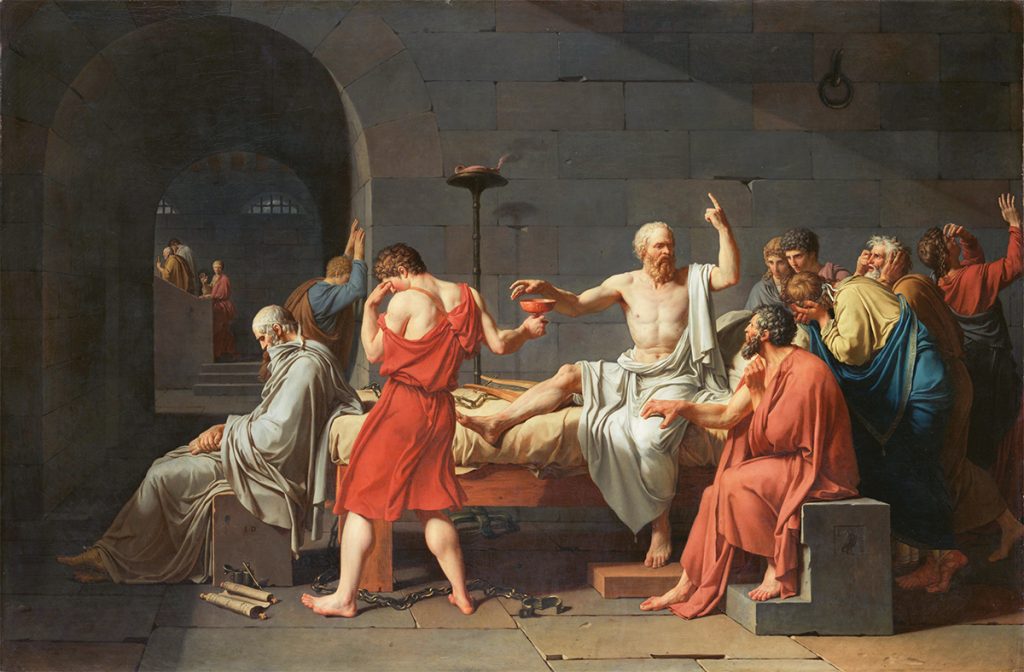
Jacques-Louis David, The Death of Socrates (1787) – http://www.metmuseum.org/collection/the-collection-online/search/436105, Public Domain, https://commons.wikimedia.org/w/index.php?curid=28552

Jean Auguste Dominique Ingres, La Baigneuse Valpinçon (1808) – rGallerix.ru, Public Domain, https://commons.wikimedia.org/w/index.php?curid=38286798
As classicism came into fashion, music moved out of churches and cathedrals and into royal courts, private homes, and public halls, the harpsichord was replaced by the fortepiano, and amateurs took more interest in playing the keyboard at home, often with friends in ad hoc ensembles. This opened up new markets for composers and music publishers leading to a proliferation of new types of chamber music including works for string quartet. Orchestras grew in size and became more powerful. The use of classical sonata form that imposes a ternary structure – exposition, development, and recapitulation – in contrast to the baroque binary form became the established norm in symphonies and concertos.
At the same time as these trends were transforming music, there was a neoclassical revival in the arts including painting, sculpture, architecture, and drama. Architects took renewed interest in the classical architecture of the Greeks and Romans returning to the use of, among other things, the Golden Ratio as a key proportion for buildings, the “classical orders” of columns that have sometimes been likened to musical keys or modes, and the ornamental detail associated with artefacts from antiquity. There was also a revival of the plastic arts such as the use of bronze and natural white marble favored by Greek and Roman sculptors as opposed to painted sculptures created by Baroque artists. In drawing and painting there were far less surviving artefacts from classical antiquity to use as models, but in their attempts to fashion neoclassical works, artists favored clarity of form, the use of sober colors and strong horizontal and verticals to render their themes in a timeless way. In these different artistic endeavors, the trend was toward restraint, orderliness, and predictability as exemplified by the rational philosophy embraced by the Enlightenment.
The classical period was also a time when schools for art and music began to appear. The Paris Conservatory opened in France in 1795, which is now the oldest music school still running in the world, followed by the Royal Academy of Music in London, founded in 1822. Because many of the great classical composers worked in Vienna, this period is also known as Viennese Classicism, and the composers are referred to as the First Viennese School. While the term neoclassicism is used for the contemporaneous movement in the visual and architectural arts that sought to revive ancient Greek and Roman ideas, neoclassicism is used in music to describe the revival of classical music that occurred in the early 20th century with composers such as Sergei Prokofiev, Igor Stravinsky, Paul Hindemith, Ottorino Respighi, Maurice Ravel, and many others.
Important artistic Neoclassicists include the sculptors Antonio Canova, Jean-Antoine Houdon, Bertel Thorvaldsen, and painters Jean-Auguste-Dominique Ingres, Élisabeth Louise Vigée Le Brun, Jacques-Louis David, Anton Raphael Mengs, Gheorghe Tattarescu and Anselm Feuerbach.
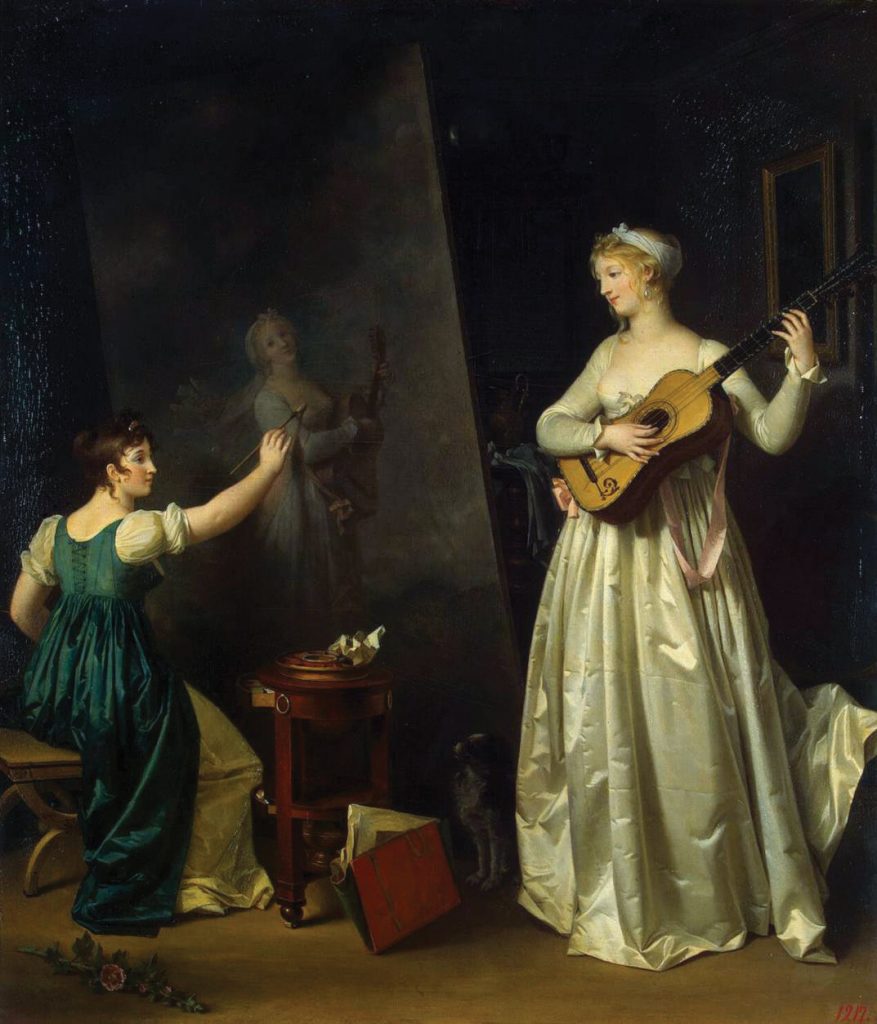
Marguerite Gérard, Artist Painting a Portrait of a Musician (1803) – Web Gallery of Art: Image Info about artwork, Public Domain, https://commons.wikimedia.org/w/index.php?curid=15394057
ROMANTICISM (c. 1780–1910)
Considered to be, in part, a reaction against the rationality of the Age of Enlightenment and the beginnings of the Industrial Revolution, Romanticism was an artistic, literary, musical and intellectual movement that began in the mid-18th century and which sought to emphasize the role of the individual and the importance of emotions, while also glorifying nature and the past.
In literature, Johann Wolfgang von Goethe provided an early example of this new focus on the emotional realm in his 1774 novel The Sorrows of Young Werther which featured a young artist with a very sensitive and passionate temperament. Werther exhibited the typical trait of a romantic figure – a person struggling to overcome an inner or outer turmoil where there is an idealization of something that is unattainable. Goethe’s novel provided an example of the emotional struggle that characterises the style known as Sturm und Drang meaning literally “storm and drive”:
“A dim vastness is spread before our souls; the perceptions of our mind are as obscure as those of our vision… But alas! when we have attained our object, when the distant ‘there’ becomes the present ‘here,’ all is changed; we are as poor and circumscribed as ever, and our souls still languish for unattainable happiness.”
— Sorrows of Young Werther, Book 1

Eugène Delacroix, Clorinda Rescues Olindo and Sophronia (1856) – https://www.sammlung.pinakothek.de/en/bookmark/artwork/A9xlB5gGWv, Public Domain, https://commons.wikimedia.org/w/index.php?curid=66327771
In paintings, we see artists attempt to be true to their own nature – anxiety, loneliness, alienation and even insanity were embraced and depicted. The end of the Napoleonic Wars (1792-1815) also provided an impetus to establish a unique German style. The representative painters of the time include Caspar David Friedrich, Philipp Otto Runge, Adrian Ludwig Richter, Ferdinand Victor, Eugène Delacroix, William Blake and Carl Spitzweg.
The Pre-Raphaelite painters founded in 1848 also belong to the Romantic era. They began as a secret society of English painters including most famously Dante Gabriel Rossetti who were opposed to what they regarded as the stale conventions at the English Royal Academy of Arts with its idealization of the Renaissance master Raphael, famed for his utopian depictions of classical beauty. They sought instead to be “true to nature” by faithful attention to detail while emulating the art of late medieval and early Renaissance Europe using a luminous palette of bright colors and subject matter of a noble and religious nature. As an equally gifted poet, Rossetti also encouraged the development of links between Romantic poetry and art. In the meantime on the German front, the Romantic movement was gaining momentum with emphasis on transcendence. Many of these Romantic developments could also be seen as a reaction to the rationalism of the Enlightenment.

John William Waterhouse, The Lady of Shalott (1888) – 1. The Athenaeum: Home – info – pic2. Unknown3. Unknown, Public Domain, https://commons.wikimedia.org/w/index.php?curid=22414821

Caspar David Friedrich, Wanderer above the sea of fog (c. 1817) – By The photographic reproduction was done by Cybershot800i. (Diff), Public Domain, https://commons.wikimedia.org/w/index.php?curid=1020146
Although Romanticism came to music somewhat later it proceeded to transform compositional style over the next century and provide what was perhaps its greatest exemplar. The writer E.T.A. Hoffman identified its origins in the later music of Mozart and Haydn leading to the early Romantic composers such as Ludwig van Beethoven, Franz Schubert, Robert Schumann, Frederic Chopin, Felix Mendelssohn, Vincenzo Bellini, Hector Berlioz and Carl Maria von Weber. Weber is often credited as being the father of the leitmotif in order to create scenarios with characters and events in absolute music, unaided by any visual sets or narration. With these and especially later Romantic composers such as Johannes Brahms, Franz Liszt, Camille Saint-Saëns, and Pyotr Tchaikovsky the soloist executed daring études and featured in concertos personifying a romantic super human figure with works exhibiting powerful chords and breathtakingly fast passages. The extroverted performer-hero would juxtapose at times with the sensitive introverted poet, wrestle with vast dynamic ranges, display florid arpeggios spanning many octaves, and showcase complex passages that were almost impossible to play to reach a spiritually transcendent realm. Late Romantics such as Richard Strauss wrote tone poems that exemplified some of the greatest Romantic themes with Ein Heldenleben literally describing a hero’s life and Don Juan depicting the rise and fall of an anti-hero.
By the late stages of this movement, the struggles of the creative genius in his imaginary universe versus the real world becomes the central theme in many works. Robert Schumann’s weaknesses, as we may call them today, were, in his time, attributed to genius and the idealized romantic tortured soul – his obsession with Clara Wieck even many years into marriage, his suicide attempts, the introspective Eusebius versus the extroverted Florestan in his music and in writings, fragmented ideas – all were celebrated and accepted traits attributed to the romantic artistic genius. The supernatural and the super ego may be best represented by Gustav Mahler, Anton Bruckner, Richard Wagner, Aleksandr Scriabin and Richard Strauss whose works take romanticism right to its precipice, to the furthermost extreme reaches of the possibilities of tonality and traditional compositional forms.
IMPRESSIONISM (c. 1875–1925)
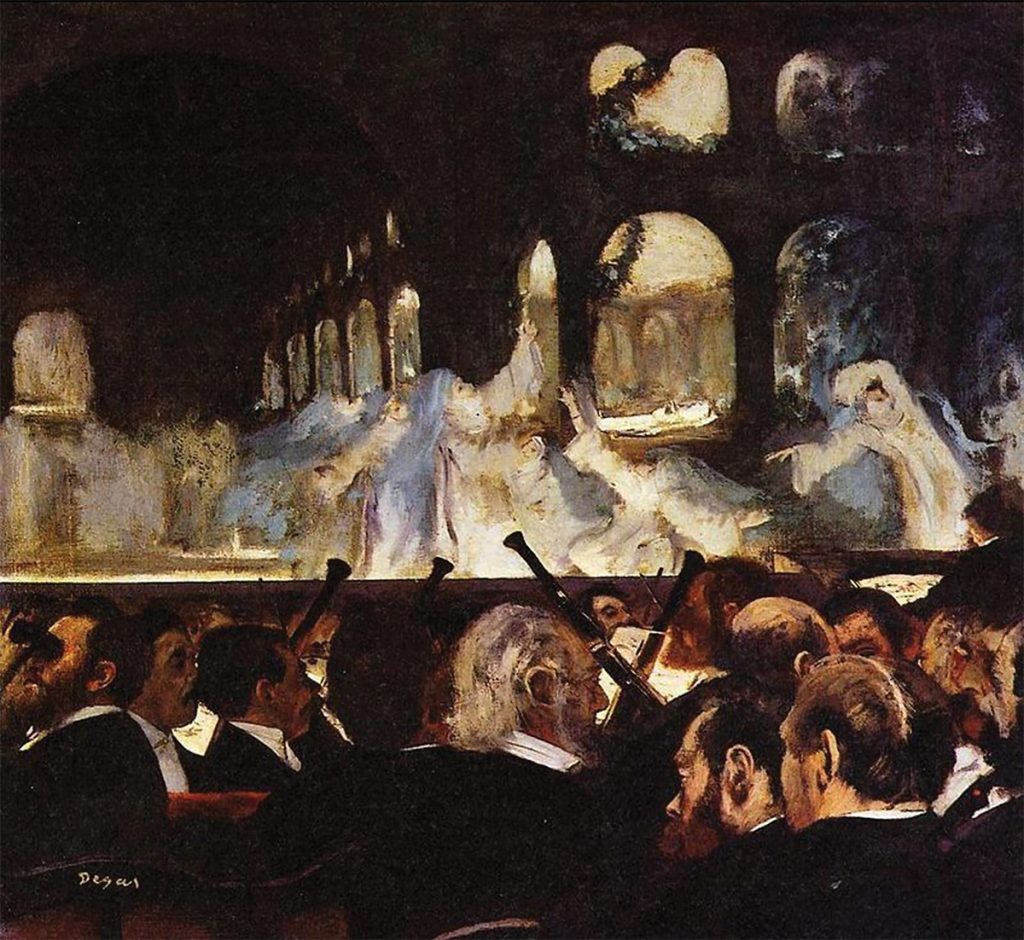
Edgar Degas, The Ballet from “Robert le Diable” (1876) – Own work Sitris, Public Domain, https://commons.wikimedia.org/w/index.php?curid=13975082
The Impressionist painters such as Pierre-Auguste Renoir, Alfred Sisley, Edgar Degas, Claude Monet, William Turner and Winslow Homer broke away from the accepted school of Realism. By taking painting outdoors to capture the light at particular times of the day, using dabs of pure unblended paint colors, working without strong lines and suggesting forms and movement of subjects, they sought to reproduce impressions of moments in their depictions of everyday scenes. These developments were deemed radical and were not welcomed by the public and critics. Although it was initially an unapproved style, the artists who were either friends or came from the same teachers’ studios, persisted along their path regardless, experimenting with ever more innovative perspectives and heartily supporting each other’s efforts. Eventually, there came a point when it was no longer even an issue of whether the movement was accepted by the establishment. Theirs became the new standard.

Claude Monet, Impression, Sunrise (1872) – art database, Public Domain, https://commons.wikimedia.org/w/index.php?curid=23750619
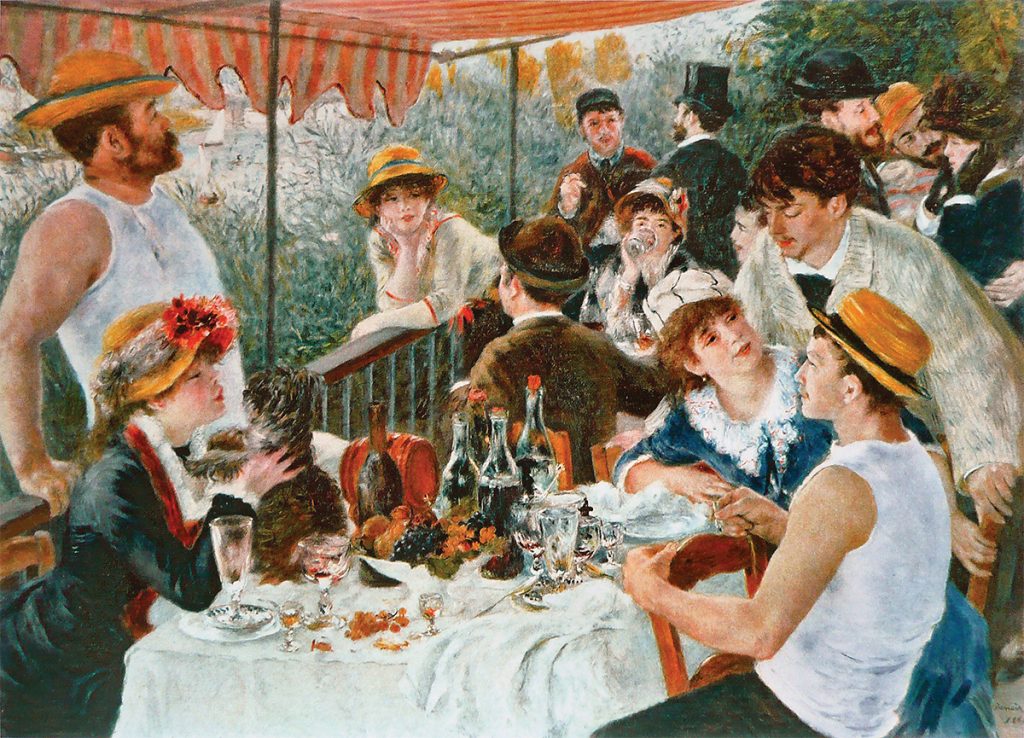
Pierre-A – Renoir, Le Déjeuner des canotiers (1881) – au XXe siècle : catalogue de l’exposition à Paris, Galeries Nationales (Grand Palais, Champs-Élysées), 23 septembre 2009 – 4 janvier 2010 , à Los Angeles, Los Angeles County Museum of Art, 14 février – 9 mai 2010 et à Philadelphie, Philadelphia Museum of Art, 17 juin – 6 septembre 2010. ISBN 9782711855872, Public Domain, https://commons.wikimedia.org/w/index.php?curid=12314857
By using whole-tone scales, the pentatonic scale and diminished seventh chords, composers around the same time in the late 19th century started to obscure tonal centers and avoid the more traditional harmonic progressions so that we, the listeners, would sense ambiguity. In addition, they started to use more complex meters and subdivide the beat to blur the effect of the bar line.
Claude Debussy remains to this day perhaps the best known of these so-called Impressionist composers. He developed an approach that evokes mood and atmosphere using instrumental timbres that created shimmering soundscapes, exotic harmonies and scales, ambiguous tonalities, large unresolved chords, and an avoidance of traditional musical form. Diminished seventh chords were employed as gateways to distant key centers, and the traditional function of harmonies were subdued. However, he disliked the label ‘impressionism’ when applied to his music, writing in a letter: “What I am trying to do is something different — an effect of reality, but what some fools call Impressionism, a term that is usually misapplied, especially by the critics who don’t hesitate to apply it to Turner, the greatest creator of mysterious effects in the whole world of art.” The ‘Impressionist’ label stuck nevertheless to Debussy and not to his disadvantage.
One reason for the popular appeal of Debussy’s music is precisely because people feel some resonance with the idea of visual impressionism when they hear his works. He also remarked, ‘Music expresses the motion of the waters and the play of curves caused by changing breezes’ – which showed his keen awareness of depicting movement in art which is again, a characteristic of this style. It’s helpful to remember how the ambiguities we see in the great impressionistic works of art enhance the mystique and intrigue of their subjects. Similar feelings may be evoked when we listen to the enigmatic and uncertain sonorities inherent in impressionistic music. In both art and music, things that are left unstated or left in the shadows can add greatly to the overall effect.
Maurice Ravel often gets put into the impressionist category too, but defying the clean categorization this implies, some of his music such as Le Tombeau de Couperin reflects neoclassical tendencies which were something of a polar opposite in that they aimed for clarity and order. Also just because composers lived in the same time period does not necessarily mean they subscribed to the same aesthetic realms. Nevertheless, Ravel was a brilliant orchestrator and his orchestrated version of Debussy’s piano works are a testament to his understanding and respect of the musical impressionist style. Gaspard de la nuit by Ravel is a masterwork with fantastic imageries, beautiful depictions of events, movement and settings.
Other notable composers associated with this style include Isaac Albéniz, Frederick Delius, Paul Dukas, Erik Satie, Enrique Granados, Alexander Scriabin and Jean Sibelius, but yet again one can see a huge variety of individualized styles in their work.
THE MODERNISTS (c. 1890–1975)
“Color is the keyboard, the eyes are the hammers, the soul is the piano with many strings. The artist is the hand that plays, touching one key or another purposely, to cause vibrations in the soul.”
Wassily Kandinsky ‘The Effect of Color’ (1911)
The beginnings of an anti-realist movement were already apparent in the works of Paul Cezanne, Vincent Van Gogh, Paul Gauguin and Georges Seurat. In music the departure point appears to have been in the late works of Claude Debussy or in the very last works such as Nuage gris by Franz Liszt. These artists and composers began obscuring the lines of realism by applying blurring techniques such as pointillism and causing ambiguity through symbolism. By emphasizing emotions, moods, ideas, and subjectivity in contrast to the more direct representational methods from the classical period, Symbolists developed new means to express their dreams and visions. Their themes often dwelt on the occult, on the erotic, on evil, and on death. The approach of various Post-Impressionist artists led to geometric Cubism and the less structured Abstract Expressionism.
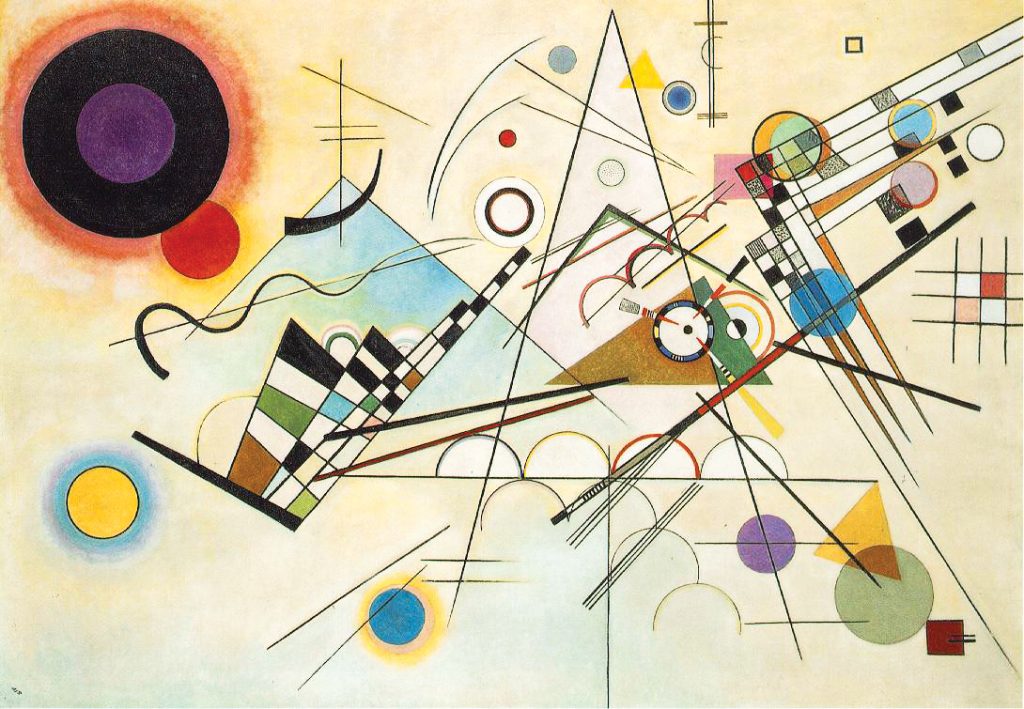
Wassily Kandinski, Composition 8, huile sur toile (1923) – http://www.ibiblio.org/wm/paint/auth/kandinsky/, Public Domain, https://commons.wikimedia.org/w/index.php?curid=37610963
As we touched on in the previous article on Nationalism with the Russian Five, the adventuresome spirit of artists can sometimes be attributed to a lack of rigorous training. The painter Wassily Kandinsky is another good example. In 1896 at the age of 30 having worked as a lawyer and economics instructor, he suddenly changed course to become an artist. Kandinsky was initially influenced by the pointillist technique employed by Claude Monet which depicts objects using contrasting dots of paint, but he gradually transitioned into completely abstract depictions that took the idea of points in space to a whole new level. Kandinsky held the belief that painting could evoke sounds the way music called to mind certain colors and forms. In 1911 he wrote a short book ‘Concerning the Spiritual in Art ’ that had a profound impact on Arnold Schoenberg, Alban Berg and Anton Webern, who attempted to incorporate his ideas into their music leading to what became known as the Second Viennese School.
Here again, just as we saw with the emergence of numerous Nationalistic styles, we see how Schoenberg and his followers reinforced each other’s efforts establishing a new style. Schoenberg pioneered a structured approach to atonality using the idea of a twelve-tone row in which some sense of unity in a piece of music could be retained by the use of a set sequence of the twelve notes of a chromatic scale. The technique of serialism and in particular the twelve-tone method has had huge influence on many modern composers that still holds sway even today. Igor Stravinsky was initially averse to serialist ideas although he was much influenced by the Cubism of Pablo Picasso, with whom he was good friends. But after the death of Schoenberg in 1951 he started taking more interest in twelve-tone techniques and started applying them in his later works such as the ballet Agon.

Vincent van Gogh, Die Kirche von Auvers (1890) – repro from artbook, Public Domain, https://commons.wikimedia.org/w/index.php?curid=9521996
DADAISM, AVANT-GARDE AND ‘ANTI-ART’
The aesthetic aim in modern art movements was no longer simply a pursuit of ‘beauty’. The artists meant to upset the audience’s perception of their existence and expectations. Their work sought to raise questions and doubts about the society in which they lived and continually questioned ‘What is the role of the artist?’ and even the ultimate question of ‘What is art?’
In the well-known work ‘4’33” by John Cage, the score instructs the performer(s) not to play their instrument(s) during the entire duration of the piece throughout the three movements. The idea is that the listener is there long enough during its performance to start questioning in his mind ‘is this actually music?’ but that was intended to be exactly a part of the experience. Another of his works, Water Music, is one in which I had a very hard time hunting down a slide whistle and a venue where an organizer felt comfortable with water on the stage. Others went their own individual ways to find ways to break with convention: Darius Milhaud and Karlheinz Stockhausen were each unique and have left their indelible mark on the world while searching for their own answers to how they each defined art. These composers found ways to challenge what was the accepted norm – because the place society was heading to and how it was thinking was not working: people living in Europe in this time period witnessed and experienced the ravages of the world wars. Even in our minds today, if we were up close and experiencing a war first hand, we would probably also wonder how any of it makes any sense. The composers and artists during this time were each creating their own art movements, perhaps as a mirror of the nonsensical world they saw around themselves.
Out of the dozens of art modern art movements that have arisen, the ones most often cited include the following which I have summarized using thumbnail descriptions courtesy of The Art Story (theartstory.com):
Abstract Expressionism:
A tendency among mainly New York painters after World War II, all of whom were committed to an expressive art of profound emotion and universal themes. Abstract Expressionism embraces the spacial breakthroughs of Jackson Pollock, color field painting of Mark Rothko, as well as the gestural abstraction of Willem de Kooning. Most were inspired by Surrealism and abstract art to create a new style fitted to the post-war mood of anxiety and trauma. Their success set the stage for America’s post-war dominance of the international art world.
Political instability in Europe in the 1930s brought several leading Surrealists to New York, and many of the Abstract Expressionists were profoundly influenced by Surrealism’s focus on mining the unconscious. It encouraged their interest in myth and archetypal symbols and it shaped their understanding of painting itself as a struggle between self-expression and the chaos of the subconscious.
Bauhaus:
A style and movement associated with the Bauhaus school, an extremely influential art and design school in Weimar Germany that emphasized the functionality and efficiency of design alongside its material properties. Prominent teachers include Josef Albers, Walter Gropius, Wassily Kandinsky, Ludwig Mies van der Rohe, and Paul Klee.
The motivations behind the creation of the Bauhaus lay in the 19th century, in anxieties about the soullessness of manufacturing and its products, and in fears about art’s loss of purpose in society. Creativity and manufacturing were drifting apart, and the Bauhaus aimed to unite them once again, rejuvenating design for everyday life.
Dada:
Dada emerged in the early twentieth century as a literary and artistic movement that celebrated random chance, ready-made artworks, and outrageous performances. Its practitioners, including Hugo Ball, Tristan Tzara, and Marcel Duchamp, scorned bourgeois conventions of high culture, especially the appreciation for artistic intention and skill.
Dada was the first conceptual art movement where the focus of the artists was not on crafting aesthetically pleasing objects but on making works that often upended bourgeois sensibilities and that generated difficult questions about society, the role of the artist, and the purpose of art.
Expressionism:
Expressionism is a broad term for a host of movements in early twentieth-century Germany, from Die Brücke (1905) and Der Blaue Reiter (1911) to the early Neue Sachlichkeit painters in the 20s and 30s. Many German Expressionists used vivid colors and abstracted forms to create spiritually or psychologically intense works, while others focused on depictions of war, alienation, and the modern city. New technologies and massive urbanization efforts altered the individual’s world view, and artists reflected the psychological impact of these developments by moving away from a realistic representation of what they saw toward an emotional and psychological rendering of how the world affected them.
Minimalism:
Minimalism emerged in the 1960s in response to the gestural and autographic excesses of Abstract Expressionism. Its early practitioners constructed huge geometric objects, serial structures, and simplified gridded planes.
The new art favored the cool over the “dramatic”: their sculptures were frequently fabricated from industrial materials and emphasized anonymity over the expressive excess of Abstract Expressionism. Painters and sculptors avoided overt symbolism and emotional content, but instead called attention to the materiality of the works. By the end of the 1970s, Minimalism had triumphed in America and Europe through a combination of forces including museum curators, art dealers, and publications, plus new systems of private and government patronage.
(Definition credits: The Art Story, theartstory.com)
IN CONCLUSION
Although the many art movements are commonly linked to other art forms including architecture, other plastic arts, philosophy and literature, the connection with parallel or similar movements in music is often curiously absent or downplayed in many writings. However, the importance of these links is strewn throughout studies of music history so it is useful to put these ideas together here in one place. Where art has canvas, the composer has the manuscript page; where there is structure and images in art there are the basic building blocks of harmony, scales, rhythm and form. So just as artists have broken with conventions of the past to create something new, so too for composers and sometimes these different spheres of activity have reflected on one another and inspired artists and musicians to cross paths in their pursuit of new experimental effects.
This brings us to today, the 21st century composers. As time passes the responsibility of interpretation becomes more challenging and the choice between faithfully executing what would have been acceptable according to contemporary aesthetics and, alternatively, reinventing the presentation of a work according to modern day sensibilities lies with the performer.
This article is in no way meant to replace a fuller investigation of any one musical or artistic style or movement, nor indeed a visit to an art museum. It is only meant to be a starting point to stimulate more interest in this extra-musical arena. My aim has been to highlight the wealth of fascinating interactions between music and art in a way that can inform our thinking when approaching works as performers. Furthermore, we can see how the collaborative spirit permeates through artistic and musical communities and how the people behind the many movements that have marked the progress of these two intertwined forms of human expression were almost always fierce advocates for the flight of the creative spirit.

Pictured (left to right): Members of the Cal Arte Ensemble based in California, USA Goetz Leonhardt, viola; Tamami Honma, piano/artistic director; Julian Brown, violin/co-founder; Yong-zi Ma, cello
Concerts work extremely well in a museum environment. I work with both living artists and composers to share their work in our programs, and engage in other creative collaborations. The Cal Arte Ensemble that I direct, based in the San Francisco Bay Area, is the ensemble-in-residence at the beautiful Triton Museum of Art in Santa Clara (rated as one of the top ten museums in the Bay Area). Last year we presented over thirty concerts including our well known Sunday Gallery series at the Triton Museum. CAE’s versatility has made possible performances of the entire Beethoven Concertos, Beethoven Piano Sonatas, Beethoven Violin Sonatas as well as many famous works by other composers written for piano trio, quartet and quintet. Some performance highlights for this coming year include a premiere for voice and piano quintet by New York composer Luis Andrei Cobo, Mozart’s Requiem (with distinguished international operatic soloists and members of the San Jose Symphonic Choir) and L’histoire du soldat (with dancers and narrators) by Stravinsky.
Art and music have a symbiotic relationship that has not only reinforced their mutual development but also the experiential effect they have on us as listeners and viewers. Our eyes and ears send signals to visual and auditory processing centers in the brain but from there information is passed on to overlapping cognitive areas that rapidly permeate our consciousness.The reception takes less than a second and yet we may be communicating with people who were creating works five days ago or hundreds of years ago. The act of performing, contemplating and listening to musical compositions, like viewing artistic works can act as an immersion into another time – the closest we can get to time-travelling. I close this article with high hopes that the sun will never set on the continued growth and development of art and music, and the continued dialogue between them.

About the author: Tamami Honma is US correspondent for Vantage and an internationally acclaimed concert pianist based in Saratoga, California. Ms Honma received her undergraduate degree and performance MMus at the Manhattan School of Music in New York, and an honorary ARAM from the Royal Academy of Music. She was a lecturer as a member of their academic faculty for a number of years before moving to the US, where she maintains a full concert schedule while also working as a private teacher and as a vocal coach at the San Francisco Conservatory of Music.
